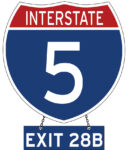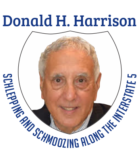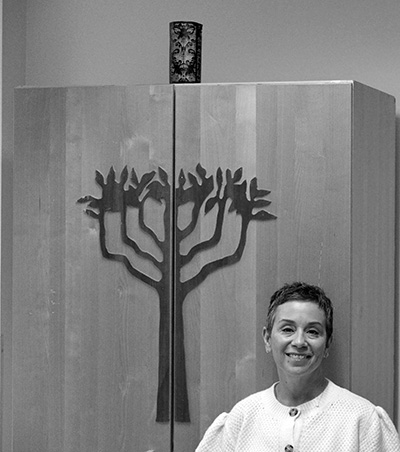 Editor’s Note: This is the 20th chapter in Volume 2 of Editor Emeritus Donald H. Harrison’s 2022 trilogy: “Schlepping and Schmoozing Along the Interstate 5.” All three books as well as others written by Harrison, may be purchased from Amazon.com.
Editor’s Note: This is the 20th chapter in Volume 2 of Editor Emeritus Donald H. Harrison’s 2022 trilogy: “Schlepping and Schmoozing Along the Interstate 5.” All three books as well as others written by Harrison, may be purchased from Amazon.com.
Schlepping and Schmoozing Along the Interstate 5, Exit 28B (La Jolla Village Drive): Congregation Dor Hadash
From northbound Interstate 5, take Exit 28B (La Jolla Village Drive) and turn right (East) and follow to a left turn at Genesee Avenue. Make another left turn at Executive Drive. The Lawrence Family JCC, Jacobs Family campus, at that corner, is at 4126 Executive Drive.
 LA JOLLA, California — Rabbi Yael Ridberg describes herself as a “progressive traditional Jew.” She is the spiritual leader of Congregation Dor Hadash (New Generation), the only Reconstructionist congregation in San Diego County. One may gain an understanding of Reconstructing Judaism by comparing its stand on the concept of “chosenness” with those of other movements.
LA JOLLA, California — Rabbi Yael Ridberg describes herself as a “progressive traditional Jew.” She is the spiritual leader of Congregation Dor Hadash (New Generation), the only Reconstructionist congregation in San Diego County. One may gain an understanding of Reconstructing Judaism by comparing its stand on the concept of “chosenness” with those of other movements.
In the other movements, in the prayer that a congregant says prior to the reading of the Torah, there is a Hebrew phrase that refers to God as the One “Who has chosen us among all peoples and given us the Torah.” In Orthodox congregations, this is taken to mean that Jews are a people who are particularly special to God.

The Conservative movement, in which Rabbi Ridberg grew up, “maintains the phrase and understands it to mean not a statement of superiority but a statement of uniqueness,” she said. The Reform movement, with which Ridberg worked closely at the Religious Action Center of Reform Judaism in Washington D.C., keeps that phrase but “interprets this as ‘we are a light unto the nations. We have something to offer to the world, no better than anyone else, but we have something to offer.’”
The Reconstructing Judaism movement, which ordained Ridberg as a rabbi in 1997, eliminates the concept of chosenness from that blessing, as well as from other prayers that appear in the Jewish liturgy. The movement’s founder, Rabbi Mordecai Kaplan (1881-1983), reformulated the blessing to say, “Who has called us to Your service and has given us the gift of Torah,” she said.
Reconstructionists are “affirming in that moment what we are called to do, rather than separating ourselves or distinguishing ourselves from other people or other faiths or denominations doing the exact same thing,” Ridberg explained.
Initially called “Reconstructionist Judaism,” the movement has identified itself as “Reconstructing Judaism” because “we are not finished in the constant process of reconstructing, reimagining how Judaism can be alive and relevant in this moment,” she said.
Ridberg had plenty of opportunities to compare the different denominations of Judaism before she committed to Reconstructing Judaism. As a child in Rockville, Maryland, she attended the Charles E. Smith Jewish Day School, which offers classes from kindergarten through 12th grade. Her family belonged to a Conservative synagogue. After graduating with a major in women’s studies and communication arts from the University of Wisconsin at Madison, she worked with the Reform movement in Washington D.C. In the nation’s capital, she also attended the non-denominational Farbrengen Havurah, “one of the oldest havurot that came out of the 1960s-1970s era.”
“My farbrengen experience gave me a very different modality of Jewish expression that I hadn’t experienced as a kid growing up in a traditional Conservative congregation,” she said. Under the mentorship of Reconstructionist Rabbi Sharon Kleinbaum, who had been ordained in 1990, Ridberg “discovered that there was a name, brand, or denomination for the kind of Judaism that I was practicing.”
The characteristics of that denomination, she added, included being “very Hebrew literate, very knowledgeable about tradition, participatory and welcoming – a kind of ongoing imaginative Jewish story, and that was very appealing to me.”
When she decided to become a rabbi, Ridberg applied to both the Reform and Reconstructionist movements, deciding after a visit to the Reconstructionist Rabbinical College in Philadelphia that this was the movement to which she should belong.
Following her ordination, she initially served as the first Marshall T. Meyer Rabbinic Fellow at Congregation B’nai Jeshurun in New York City. Next, she served at the West End Synagogue in New York City initially as an associate rabbi and later as the congregation’s sole rabbi. Overall, she spent 12 years as a rabbi in the “mecca of Jewish life, New York City” before moving to San Diego with her husband, ecologist Mark Laska, and daughters Gali, Jaidyn, Aviv, and Raven.
In San Diego, Ridberg accepted a job as a part-time rabbi at Congregation Dor Hadash, which had been founded in 1983 by Reform Movement-trained Rabbi Ron Herstik. The founding rabbi was succeeded in 1996 by Rabbi Alexis Roberts (today Alexis Pearce), and in 2005 by Rabbi Yaffa Shira-Sulton. The congregation had moved several times since its founding. It started in rented quarters at a church in Pacific Beach, then moved to another church in La Jolla and then rented space at the Lawrence Family JCC before settling into an office suite on Ronson Court in the Kearny Mesa area. The congregation eventually grew to its current membership of approximately 110 families. In 2012, noting that demographically the Jewish community was moving northward, Ridberg arranged with Rabbi Philip Graubart, who was then the spiritual leader at Congregation Beth El in La Jolla, to utilize space in Beth El’s social hall.
“We held our services in the upstirs Beit Midrash, which is an upstairs library space,” and moved downstairs to larger space for more heavily attended celebrations such as b’nai mitzvah,” Ridberg said. Meanwhile, Rabbi Ridberg and the staff of Congregation Dor Hadash worked from rented office space at the San Diego Jewish Academy, “which was a wonderful opportunity, certainly for me as a parent at the school.”
Rabbi Ridberg also became an SDJA board member, rising to its presidency. Eventually, it was decided to have both the office and the services at the San Diego Jewish Academy after space became available with the remodeling of the library. After a few years, however, SDJA needed to reclaim the space for its growth, prompting the JCC’s executive director Betzy Lynch to suggest that Dor Hadash return to the JCC. Ridberg said the JCC is widely known and used by San Diego’s Jewish community, providing more visibility for her congregation. She said it was good “to feel connected with an organization that is so clearly promoting of Jewish communal life and aligned with our mission and our organization.”
“Dor Hadash is a covenantal community, a conscious community,” Ridberg told me. “People make a choice to join because it speaks to their hearts, either because they feel fully seen whereas before they didn’t, or perhaps because they like the way Judaism is presented. They are allowed to ask questions, to be seekers, to be generators of their own Jewish life. It is joyful and loving and people really care about each other. It might not be the most observant community ritually, but it is a very observant community culturally. Everybody feels like they are in their home. We show up for each other in loss, in celebration, and in wanting to make the world a better place. Because it is small and because we are nimble and flexible, we really can create community in our village. It is a powerful decision to want to be part of a community that is still a laboratory — we’re still constructing and reconstructing.”
As a part-time officiant at Dor Hadash, Ridberg has the time not only to volunteer at the San Diego Jewish Academy but also to teach at the Jewish Federation of San Diego and at the Lawrence Family JCC. She also participates in the San Diego Rabbinical Association, provides officiant services at life cycle events, and deeply engages in justice work. “I am one of the rabbis who gets a phone call to show up at a rally or a vigil when, God forbid, something terrible happens in the world, or to stand with other faith leaders in solidarity around issues that matter to all of us. I have greater flexibility than some of my colleagues who are full-time rabbis and don’t necessarily have the ability to easily be engaged in those kinds of volunteering.”
Ridberg also is a fan of collaboration. Her congregation has celebrated Tashlich with Ohr Shalom Synagogue “every year since I got here.” She has helped produce community-wide programs for Selichot and Shavuot, and always “jumps at the chance to partner with other congregations and agencies.”
When she is not in the pulpit, Ridberg attends services with her family at Congregation Beth El, a Conservative congregation. As her daughters became bnot mitzvah, they made it clear to her that they wanted her in the congregation, not on the bima, during the ceremonies, so that she could be a parent and not have to worry about the pace of the service.
Upon accepting her position at Dor Hadash, Ridberg decided “I didn’t want to live in a silo. Not only didn’t I think that Jews are the ‘chosen’ people, I didn’t think that Dor Hadash was the ‘chosen’ congregation. I wanted to make sure that as a community we were really good citizens, that we were good partners in Jewish communal life and that we are good San Diegans. I was able to bring a sensibility of wanting to collaborate and build relationships and partnerships across all lines and divides.”
“I feel that there are plenty of Jews to go around in San Diego; I don’t see any reason for competitiveness between San Diego synagogues,” she said. “That is why Baskin Robbins has done so well with 31 flavors. There is something for everyone. I believe that about Jewish life in San Diego. I believe that people have to decide for themselves that they want it, and then they go out and find it. There is something for everyone with every kind of Jewish experience.”
*
Donald H. Harrison is editor emeritus of San Diego Jewish World. He may be contacted via donald.harrison@sdjewishworld.com